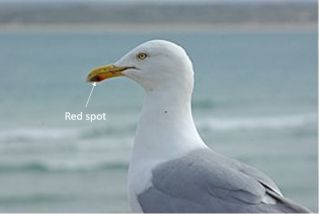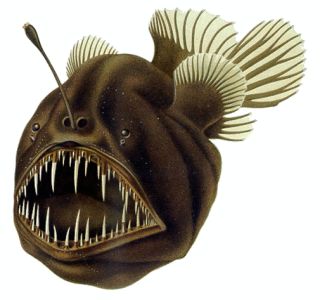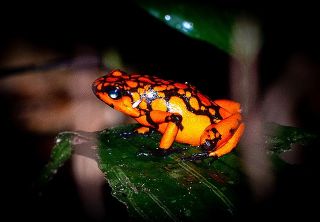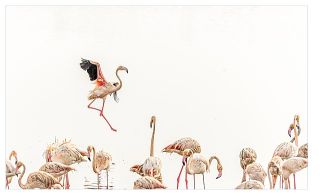Environment
How to Get Noticed When You're Invisible
Stealing a page from nature’s playbook.
Posted March 23, 2023 Reviewed by Michelle Quirk
Key points
- To get your first job, often you must have already had a first job for recruiters to notice you.
- Yet, some people break this vicious circle by using the same strategy wild animals use to get noticed by other animals.
- Animals present highly specific "salient" features that uniquely match exactly what their "audience" is looking for.
Many of us have experienced a vicious circle that stands in the way of success: To get a good job you need experience, but, to get that experience, you had to have first gotten the same job somewhere else. To sell a new product, you must first have already sold them to someone else. Or, to get a publisher to take your writing seriously, you need to have a “big name,” but to get a “big name,” you must have already been published.
No one takes you seriously until you get on their radar screen, but you can’t get on the radar screen unless someone has already taken you seriously.
And, yet, some people still do manage to get that first job, first publication, first acting gig, first promotion, first hit song, etc. How do they beat the vicious circle?
Timing and luck do play a big role. For instance, Mel Gibson got cast in his debut, breakthrough role in "Mad Max" after getting noticed when he dropped off a friend to audition for the movie. Gibson was simply lucky enough to be in the right place at the right time, right?
Well, not entirely. The night before the actor got his big break, he had gotten into a bar fight and looked “roughed up,” which just happened to be the gritty look the casting director was looking for.
In other words, Gibson, in addition to being handsome and charismatic, displayed that special nasty something that was the very thing people in power were looking for.
How Nature Gets Noticed

In ethology (the study of animal behavior in the wild) that special something is referred to as salience.
For instance, for the Herring gull, the redder and bigger the spot on a mother gull’s lower beak, the more her chicks will peck at the beak for food (and thus grow and thrive) because redness and size of that spot are salient cues to elicit pecking behavior. This is so much so, that when gull chicks are presented with a choice between their mother’s beak and an enormous red disc, they ignore their mother and peck at the disc.
Put another way, to get the chicks to notice the mother’s beak, the redder and bigger the red spot on the beak, the better.

The angler fish, which dangles wormlike “bait” right in front of its ravenous jaws, is another example of stimulus salience for smaller fish upon which the angler preys. When smaller fish take the bait, the angler snacks on them.
Sometimes, animals try hard to get noticed so that others will avoid, not approach them.
Poison dart frogs take on a blue color that is highly conspicuous (and, therefore, salient) against green vegetation, a strategy that is also adopted by the frog’s orange cousins. These highly saturated skin colors act as the opposite of camouflage, proclaiming to the world “notice me, and go around me!”
Stealing a Page From Nature’s Playbook
%20_cliff_cc2.jpg?itok=6hAEgJtB)
OK, so billions of years of evolution show that the way to get noticed is to look exactly like that salient something someone is looking for. This suggests that the key to getting noticed is to get inside the person’s head you want to notice you and learn what is most salient to them. Sometimes these “noticers” are looking for attractors (analogous to the mama gull’s beak) and sometimes they are looking for nastiness (like the poison dart frog’s skin).
In the attractor category, sometimes your target audience will tell you exactly what is most salient to them. Inc. Magazine, for example, on their Web site, says that they want stories that M.O.V.E. (are Meaningful, Original, Valuable, and Entertaining), then they explain in depth what each of these salient attributes means.

In the nastiness category (where the target audience is looking for bad*ss), it’s possible to learn by observation what works best. If, for example, you wanted to get on a reality show (such as "The Bachelor" or "The Bachelorette"), one proven strategy is to watch a lot of shows, then learn to present yourself as previous, compelling “villains” who were highly competitive and insensitive to the feelings of co-contestants. Reality shows need the “good vs. bad” storyline to create conflict that sustains audience interest.
Formally trained in ethology, I confess (with some embarrassment) to having used salient nastiness to advance my corporate career by noticing that executives where I worked tended to promote task-master “bad boys” who were comfortable with—and good at—confrontation. So that’s the persona I adopted, with the result that I once got bumped up three levels in one promotion to “fix” a broken organization by “kicking butt and taking names.” (I failed, incidentally, then got demoted, because salience does not equate to competence.)
The Bottom Line
Now, as a writer, far removed from the corporate rat race, I pay a lot of attention to successful first-time authors to observe what sets them apart and enables them to break out of the vicious circle that holds so many back.
And my conclusion from these observations is that animal behavior and the science of salience once again hold the answer to breaking vicious circles. Below, in this flock of flamingos, the eye is drawn not to what is “normal” (relatively inactive flamingos) but to what is unique (the active, flying flamingo).

So, too, in publishing, virtually all breakthrough writers (such as J.K Rowling with her first Harry Potter novel) offer stories and characters that stand out from the crowd as unique. And job applicants who lack the “normal” qualifications that employers require can still get hired if they stand out as unique in some way. I once hired an inexperienced engineer only because that individual possessed a unique, insatiable curiosity to learn about technologies far outside their formal training because I had noticed that the most successful technologists displayed an exceptional breadth of interests.
Whether it’s the animal world, the publishing world, the job market, or the market for products and services, uniqueness is the surest way to salience and to ultimate success.
And the way to learn what is unique is to carefully notice what noticers notice.
As Yogi Berra opined, “You can observe a lot by watching.”




